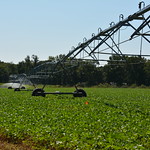What does a progressive farm look like? Consider the aspects of farms described by this New York Times article.
- Cloud computing
- Data is everything (big data, data analysis, and shared and private data)
- Potential robotics (weed detection)
- Unmanned aerial vehicles (drones)
- Satellite technologies:
- GPS
- GIS
- yield monitors (real time data on yield and moisture)
- variable rate applicators (fertilizers, seed, and irrigation)
- precision operations (inch accurate rows)
- autosteer tractors (driveless)
- electrical soil mapping
- electrical charged soiled testing
- Social media
- Partnerships
What does this mean for agriculture in the United States? Possibly bigger farms and fewer diverse farms, which does not necessarily lead in a negative direction. It also means more information on environmental treatments and eventually leading to tracking food to its source.
Tom Farms recognizes, like most progressive businesses, that technology is used to garner and process lots of information for management decisions. Growth on these farms is dependent on managing and deciphering precise and massive amount of information. In part, Tom Farms' growth is enhanced by those farms that continue to look at using more inputs, fertilizers and horse power and are not utilizing the power of information.
Tom Farms recognizes, like most progressive businesses, that technology is used to garner and process lots of information for management decisions. Growth on these farms is dependent on managing and deciphering precise and massive amount of information. In part, Tom Farms' growth is enhanced by those farms that continue to look at using more inputs, fertilizers and horse power and are not utilizing the power of information.
Farmers still think tech means physical augmentation — more horsepower, more fertilizer,” Mr. Tom said. “They don’t see that technology now is about multiplying information.” With corn prices at almost half the level they have been in the past few years, “my growth is going to come from farmers who don’t embrace technology."Enabling technology can also cause conflicts and adjustments in the way farmers work. Farmers tend to be very independent but with big data -- their own and their neighbors' data -- more information can yield benefits to all. On the flip side, there continues to be a need for proprietary control. Sharing data puts individual farmers at risk but also could yield benefits to them individually and collectively, similarly, much like other industries.
“We and the other farmers could pool all our harvest data in real time,” he said. “You think the big companies would like that? You bet they would. Farmers don’t trust that; they’re independent. Your neighbor is also your competitor.The most competitive farms will utilize masses of precise information gathered via technology and are able to sift through and analyze these layers of data to make decisions. These farms will also use partnerships for strategic and collective benefit.
